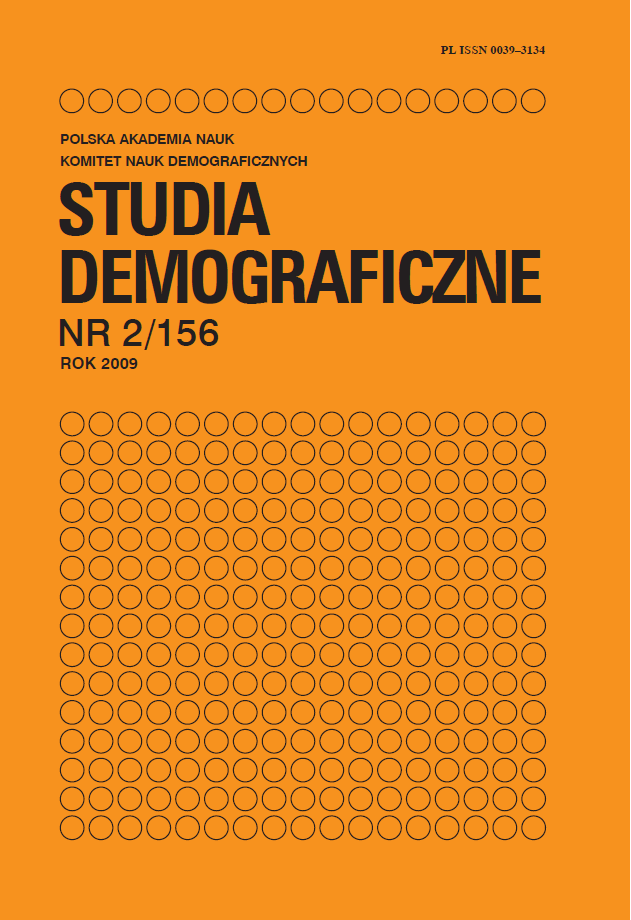Cykliczność zmian liczby urodzeń na przykładzie wybranych krajów
Main Article Content
Abstract
In long time series of economic variables, regular trends as well as cyclical fluctuations can be observed. Similar components of long-term changes might be distinguished for demographic processes. This article aims to identify cyclical fluctuations in long-term changes of the number of births in 31 countries. The data come from the Human Mortality Database, and the time series consist of between 48 and 259 observations. In this study, a modified procedure to determine cyclical features of long-term time series was applied, which resulted in identifying turning points, phases of contraction and expansion, amplitude of phases, duration of phases and intensity of changes, and duration of cycles for each country.
Comparative analysis of different characteristics of cyclical fluctuations made it possible to determine main features of long-term changes in the number of births, similarities and differences of cycles across groups of countries, and the sub-periods distinguished. The expansion phase was found to usually last longer, and its intensity to be weaker, as compared with the contraction phase. In the 20th century, especially after the Second World War, it was found that the countries under study were becoming increasingly similar in terms of the timing of turning points in the trends of birth numbers.
Article Details
References
[2] Bourgeois-Pichat J., 1979, La baisse actuelle de la fécondité en Europe s’inscrit-elle dans de modéle de la transition déographique?, „Population” No. 2, 167–306.
[3] Bubnowa H., 1989, Falowanie demograficzne. Przyczyny, charakter, prognozy, „Studia Demograficzne” nr 1 (95), 35–53.
[4] Easterlin R.A., 1966, Economic-demographic interactions and long swings in economic growth, „American Economic Review”, 1063–1104.
[5] Easterlin R.A., 1975, Analyse de la fécondité dims un cadre économigue approprié, „Etudes de planning familial”, 87–101.
[6] Holzer J.Z., 1964, Urodzenia i zgony a struktura ludności Polski, PWE, Warszawa.
[7] Holzer J.Z., 1984, Wyże demograficzne w Polsce. Analiza porównawcza, „Studia Demograficzne” nr 4 (78), 55–69.
[8] GUS, Roczniki Demograficzne GUS za lata 1950–2007, GUS, Warszawa.
[9] Holzer J.Z., Mlącki B., 1980, Wyznaczanie roczników wyżu i niżu demograficznego w Polsce. Zakres falowania liczebności wybranych grup wieku, „Studia Demograficzne” nr 3/4 (61/62), 29–45.
[10] Human Mortality Database, 2009, zasób internetowy, www.mortality.org (data dostępu 10.03.2009)
[11] Hübner D., Lubiński M., Małecki W., Matkowski Z., 1994, Koniunktura gospodarcza, PWE, Warszawa.
[12] Krupowicz J., 2000, Koncepcja zmiennych wyprzedzających i naśladujących w badaniach koniunktury demograficznej w Polsce, „Studia Demograficzne” nr 1 (137), 97–129.
[13] Krupowicz J., 2001, Sygnalizatory przemian demograficznych w Polsce, Zeszyty Naukowe Sekcji Analiz Demograficznych KNDPAN, nr 3/2001, 5–21.
[14] Krupowicz J., 2009a, Wykorzystanie zmiennych wyprzedzających do prognozowania procesu urodzeń, „Prace Naukowe Uniwersytetu Ekonomicznego we Wrocławiu” nr 38 – „Ekonometria – Prognozowanie” nr 24, 21–35.
[15] Krupowicz J., 2009b, Zmiany struktury populacji kobiet w okresie zdolności rozrodczej a kształtowanie się procesu urodzeń w Polsce – propozycje w zakresie prognozowania, „Zeszyty Naukowe Sekcji Analiz Demograficznych KNDPAN”, nr 20, s. 44–63.
[16] Lahiri K., Moore G.H. (red.), 1991, Leading Economic Indicators. New Approach and Forecasting Records, Cambridge University Press, New York.
[17] Lesthaeghe R., Despontin M., Page H.J., Wijewickrema S., 1979, Płodność oscylująca; mechanizmy wzmacniające i tłumiące, „Studia Demograficzne” nr 57/58, 39–57.
[18] OECD, 1987, Leading Indicators and Business Cycles in Member Countries. Sources and Methods 1960–1985, No. 39, OECD, Paris.
[19] Rekowski M. (red.), 1997, Koniunktura gospodarcza Polski. Analiza grup produktowych, AKADEMIA, Poznań.
[20] Romaniuk K., 1968, Rola wyżu demograficznego w kształtowaniu się struktury i dynamiki ludności w Polsce, [w:] Społeczno-ekonomiczne problemy wyżu demograficznego. Warszawa.
[21] Rosset E., 1975, Demografia Polski, PWN, Warszawa.
[22] Vielrose E., 1980, Cykliczność w zjawiskach demograficznych, „Studia Demograficzne” nr 2 (60), 51–57.
[23] Vielrose E., 1982, Wpływ koniunktury gospodarczej na ruch naturalny ludności w Polsce międzywojennej, „Studia Demograficzne” nr 2 (68), 19–26.
[24] Zając K., 1981, Wzajemne uwarunkowania rozwoju społeczno-ekonomicznego i demograficznego, „Studia Demograficzne” nr 3 (65), 21–41.
